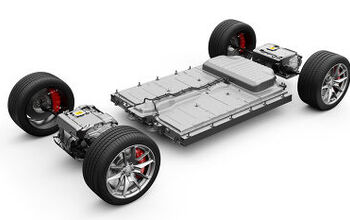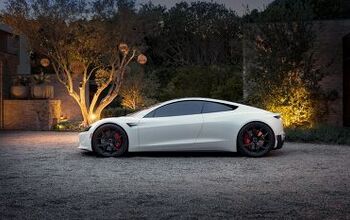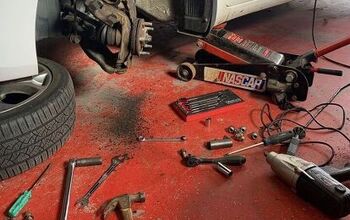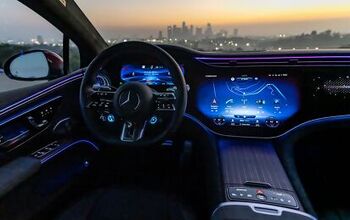Low Tech, No Tech
One afternoon, while watching a radar-controlled German ubersedan drive itself, the fading sun struck my eyes. Surrounded by microprocessors, solenoids, relays, pumps, controllers, fans, sensors, circuit boards and endlessly coursing electrons, I did what every driver must do: I reached up for a vinyl-covered board and pivoted it down to cover a small patch of windshield through which I now could no longer see. Excuse me? The $105k four-door was crowded with technology, all of it entertaining, much of it only occasionally useful. Yet no one had thought to correct, improve, replace, redesign or reconceptualize a device as primitive as the Budweiser Clydesdales’ blinders. What’s that all about?
In an era when even ordinary sunglasses readily change their opacity, and upmarket carmakers play pointless electroluminescent tricks with sunroofs, we still lower plastic panels in front of our face to block the sun on the windshield. You can't see through sunvisors. They cover only limited areas of the windshield. And because they pivot on a mechanical device as sophisticated as a drawer-pull, you can move them through, at best, two axes. In short, the sunvisor is a low-tech nightmare that needs immediate attention. In this it is not alone.
My first car was a 1936 Ford Phaeton. The vehicle had rubber strips on metal sticks that flapped back and forth to sort of clear the water off the windshield. The aforementioned 2007 supersedan has rubber strips on metal sticks that flap back and forth to sort of clear the water off the windshield glass. I've piloted Learjets that didn't have windshield wipers; they use artfully directed hot air. On final approach in the rain– the only time you're bothering to clear the windshield in a jet– the Lear wasn't going any faster than any big Mercedes, BMW or Audi.
How about jacks? Aren’t they the work of a genius? Actually they are. If you have to change a tire, you use a mechanical screw device invented during the Renaissance by Leonardo da Vinci. In fact, only da Vinci would still bother trying to use one. The rest of us call Roadside Assistance, since tires and wheels are too heavy to lift anyway. No, don’t bother telling me how much you and Pat Robertson can bench-press. The point is that the whole tire-changing ritual– jack, lug wrench, multiple nuts and studs– is still performed exactly as it was for a 1932 DeSoto.
Fuelling our cars also hasn’t changed since the Hoover administration. You unscrew a cap and stick a crude spigot into a filler pipe. Of course, this assumes you can find the artfully hidden switch that unlocks the little door covering the cap. I almost abandoned [an owner’s manual-less] Ferrari when it proved virtually impossible to locate the damn gas-flap toggle. The only part of refueling that’s improved since World War I is the gas pump itself, which now requires credit card activation.
True, there are ancient devices on/in cars that work wonderfully. A $1.29 hardware-store ignition key springs to mind. So how is it that car keys have grown in both complexity and size– to the point where I keep expecting the women in my life to ask, “Is that a luxury car key fob transponder in your pocket, or are you just happy to see me?” Heaven help you if you lose your lump in Mae’s couch; a new key now sets you back $400.
Consider hood latches. How many times have you fished around in that damn one-inch gap between hood and fan shroud, tearing gouges in your knuckles in the fruitless search for a latch release designed by a moron hewing to 100 years of tradition established by idiots? Who wrote the law that hood latches have to be accessible only by the flattened fingers of a concert pianist? Why do we need to go through the same hood-latch exercise our grandfathers did when everything else in the world can be made to answer to a remote? (The key!)
Understand that it’s the latch that pisses me off, not the opening system. To wit: Porsche has long since abandoned its perfectly good mechanical-cable hood-popping system for an electric release. So when you run the battery dead in a Porsche Boxster– easy enough to do when you raise the roof and forget to turn the ignition off– there’s no way to reach the battery. It sits quite happily underneath the electrically operated, now-immobile front hood. You have to get on your knees outside the driver's door, reach under the dashboard and use jumper cables to pop the switch that opens the front hood. Needless to say, you then have to repeat the exercise to jump the battery.
I guess we should be careful what we wish for.
I'm the automotive editor of Conde Nast Traveler and a freelancer for a variety of other magazines as well. Go to amazon.com and read more about me than you ever wanted to know if you do a search for either of my current books, "The Gold-Plated Porsche" and "Man and Machine." Been a pilot since 1967 (single- and multi-engine land, single-engine sea, glider, instrument, Cessna Citation 500 type rating all on a commercial license) and I use the gold-plated Porsche, a much-modified and -lightened '83 911SC, as a track car.
More by Stephan Wilkinson
Latest Car Reviews
Read moreLatest Product Reviews
Read moreRecent Comments
- MaintenanceCosts Can I have the hybrid powertrains and packaging of the RAV4 Hybrid or Prime with the interior materials, design, and build quality of the Mazda?
- ToolGuy I have 2 podcasts to listen to before commenting, stop rushing my homework.
- ToolGuy Please allow me to listen to the podcast before commenting. (This is the way my mind works, please forgive me.)
- ToolGuy My ancient sedan (19 years lol) matches the turbo Mazda 0-60 (on paper) while delivering better highway fuel economy, so let's just say I don't see a compelling reason to 'upgrade' and by the way HOW HAVE ICE POWERTRAIN ENGINEERS BEEN SPENDING THEIR TIME never mind I think I know. 😉
- FreedMike This was the Official Affluent-Mom Character Mobile in just about every TV show and movie in the Aughts.


































Comments
Join the conversation
The reason that hoods pop open only an inch is the federal regulation about secondary hood latches. The reason windshields are not self dimming is, again, the federal regyulations about the light transmissability of glass. Ditto for the sizeof the sunvisors. This essay should have been targeted to your congressman. Incidetnally, the heated washer fluid inthe Lucerne is about 140 deg F. That's sucha neat feature that it almost swayed my wife from the Mustang GT, butnot quite.
That's as useful as saying, "The reason that cars have incandescent sealed-beam headlights is the Federal regulation about..." Stephan Wilkinson